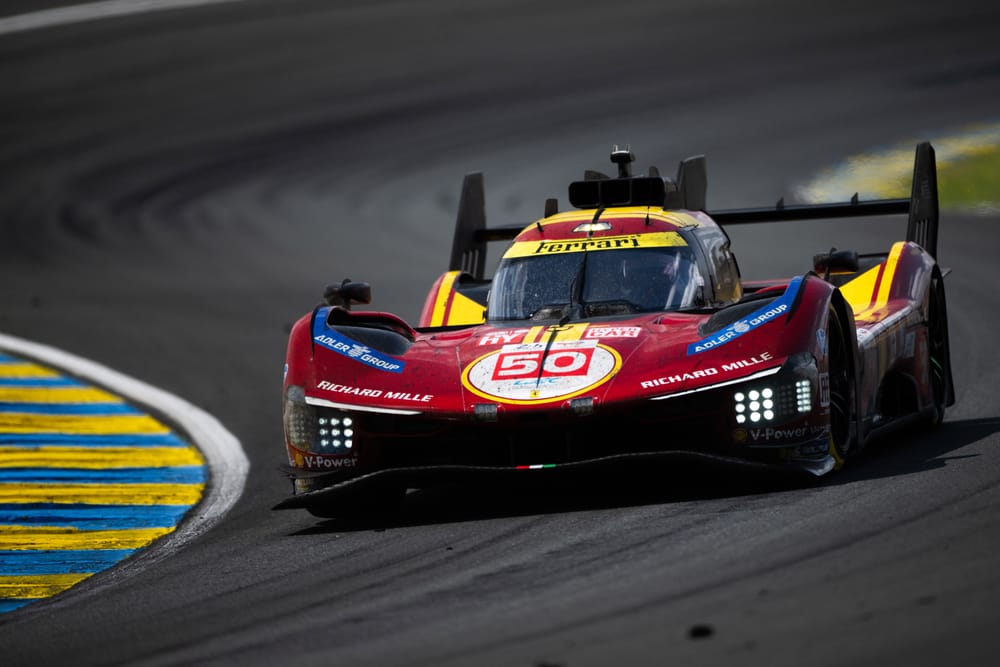The fourth placed Ferrari of Nicklas Nielsen, Antonio Fuoco and Miguel Molina has been thrown out of the results of the 2025 Le Mans 24 Hours.
Last night, we reported that the technical scrutineers had reported a technical infringement on the #50 Ferrari 499P - that it did not comply with Section 3.8.7 of the LMH technical regulations concerning the rear wing support. That regulation reads as follows:
With the endplates and rear flap connected (as in track condition), no point of the mainplane or vertical support(s) may deflect more than 15mm vertically when the following combined vertical loads are applied:
- A load of 2400N applied on the surface of the mainplane. The load will be applied in a downward direction uniformly and simultaneously at a point in x representing from 25% to 75% of the chord length of the main plane through six distinct similar pads of 200mm width, and extending from the leading edge of the wing to its trailing edge or the point of overlay of the flap if existing. Their uppermost surface will be horizontal before application of the 400N load and above the upper point of the flap.
- A load of 1000N pulling downwards on each endplate.
The penalty was swift and the disqualification notice was issued during the night. It states that Ferrari #50 has been disqualified for not complying with that deflection test.
The reasoning was:
The following irregularities were identified:
- Missing Components on Rear Wing Support: Four bolts were found to be missing from the rear wing support, as per the car’s homologation form. The Team Manager confirmed and accepted the non-compliance with the homologation specifications.
- Rear Wing Deflection: A rear wing deflection of 52mm was recorded during the post-race test, whereas Article 3.8.7 of the LMH Technical Regulations sets the maximum permissible deflection at 15mm. The Team Manager accepted the result and confirmed that the test procedure carried out by the scrutineers was correct. The Competitor did not dispute the measurement.
Ferrari's defence
The statement said Ferrari argued “that the excessive deflection was linked to the missing bolts, and claimed that no performance gain was achieved”.
Since test day, Ferrari's competitors have been surprised by the top speed of the 499P. This is especially true given that this year, the governing bodies had aimed to level the top speeds, as the Ferrari had surprisingly gained an advantage in the last two editions of the race. At 52mm versus 15mm, it is an understatement to say that the difference is huge.
The Ferraris easily shook off their rivals on the straights, unlike the Cadillacs and Toyotas. According to official documents, the two official Ferrari 499Ps were clocked at 349km/h (217mph), compared to 345.6km/h (214.7mph) for the No. 6 Porsche and 342.3km/h (212.7mph) for the fastest Toyota. This was a huge advantage, given the importance of top speed on the Le Mans 24 Hours circuit.
The officials’ statement said Ferrari had noticed one of the missing bolts but taken no action, and disputed the team’s argument that it had made no straightline speed difference:
It was further explained that during the last pitstop at 15:23, a mechanic noticed the absence of only one bolt on the rear wing support, but no corrective action was taken before the end of the race. The Competitor explained this decision was made after reviewing the car telemetry, which allegedly showed no change to the car’s speed.
The Stewards noted that Car 50 achieved its highest top speed on lap 380 out of 387.
And it suggested that the situation presented a safety risk as well as offering a performance advantage:
It is well-established jurisprudence in motorsport that non-compliance with technical regulations leads to disqualification, unless the Competitor can prove that exceptional circumstances justify otherwise, which was not claimed in this case. Moreover, the scrutineers, who are the competent authority on safety matters, considered the rear wing assembly non-compliance to present a potential safety risk. In particular, the irregular and incomplete assembly of the rear wing support presents a risk of structural failure under high-speed stress or fatigue, which cannot be overlooked.



